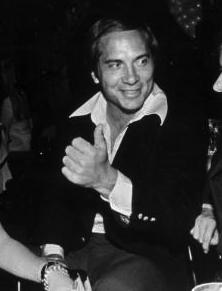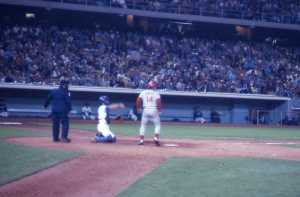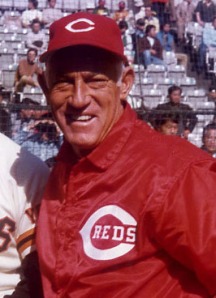Growing up in Cleveland meant baseball season was a season of heartbreak between 1960 and 1992. In fact, I’d left town before the long, painful drought ended. The Indians had their brushes with greatness since their last serious run on the pennant in 1959, but it would be 1994 before the Tribe would cease to be a perennial joke, as big of losers as the Cubs or the Mets without the lovable underdog glow of either team. Sam McDowell? Gaylord Perry? Phil Neikro? All bright spots in a lackluster era that included ten years where the team was owned by a dead man.
So what did a poor kid do in the mid-1970’s when all you had to root for was Buddy Bell standing among a team of nobodies?
Well, the mid-1970’s were the era of the Big Red Machine. Now some will point out that Cleveland and Cincinnati are rivals. That’s true, but as a baseball rivalry, Reds vs. Indians is one of the biggest yawners. Really, Browns fans used to barely notice Cincinnati until football season in an era when interleague play did not exist. And when your local team is snoozing, you look to the nearest team in the other league to carry your banner. Some would argue that the nearest National League team to Cleveland is Pittsburgh, but Clevelanders rooting for any Pittsburgh team besides the Penguins is just crazy talk. No, Clevelanders kept it in-state. And except for every Sunday during football season, Clevelanders pledged allegiance to The Big Red Machine.
When I moved to Cincinnati twenty years ago, one of the things that helped me assimilate into the city was the almost religious reverence people here hold for the Reds between 1970 and 1979. It helps that the Reds’ biggest World Series win came against the New York Yankees. And as you all know, you either love the Yankees or you hate them. Otherwise, you’re not a baseball fan. Sorry. Turn off Baseball Tonight. Go watch rugby on the Fox Soccer Channel. Maybe the hooligans will let you live.
You all know the names. Pete Rose. Johnny Bench. Joe Morgan. Tony Perez. And there are the lesser lights who still loom large in the city. Cesar Geronimo. Don Gullet. Davey Concepcion. Concepcion, in fact, started a mini-era of his own. For 34 years, from 1970 to 2004, only two men regularly played shortstop for the Reds – Concepcion until 1988, then Barry Larkin, his protege, until 2004.
Joe Morgan is probably the most visible of the former Big Red Machine players. A long-time baseball announcer, Morgan probably had his eye on the job long before he came to the Reds. In his book, Ball Four, Seattle Pilots and Houston Astros pitcher Jim Bouton relates several episodes with the ‘Stros where an up-and-coming Morgan would relieve the boredom in the dugout by imitating the television announcers calling the game. Reading those passages makes me wonder if Joe already had a sense of the man who took over the announcer’s job in his future home, Hall of Famer Marty Brennamen. Brennamen and Morgan would arrive in Cincinnati at rougly the same time. Marty, along with former Reds pitcher Joe Nuxhall, would become the voice of the Big Red Machine during their entire run and beyond.
The biggest icon, for both good and ill, of the Big Red Machine is Pete Rose. Rose, a native West-Sider, was known as Charlie Hustle. Rose played hard and didn’t respect anyone who slacked off during the game. His attitude paid off. He made the last, to date, serious run at Joe DiMaggio’s hitting streak. Joe made it to 56 games. Pete managed to post a respectable 44 games in 1978. He would later return to Cincinnati in the 1980’s to smash Ty Cobb’s record of 4191 hits. Love him, hate him, he’s as much a part of Cincinnati and the Reds as the team’s three best-known ball parks (Crosley Field, Riverfront Stadium, and Great American Ball Park), the Skyline Chili in the concession stands, and Joe Nuxhall’s voice.
The other face of the Reds during the Big Red Machine Era was Johnny Bench, the catcher and a power hitter. Johnny, an Oklahoma boy, came up through the Reds system and played his entire career in Cincinnati. And he stayed here after his career ended. One of the most noticeable things about Johnny Bench was his sizeable hands. The man could hold seven baseballs in one hands. I once delivered pizza to Johnny Bench. When he handed me his check, I caught sight of those hands up close and personal. Had we shaken hands, my own hand would have disappeared. And my hands are not exactly childlike to begin with.
 Now, of course, when you have a group of athletes with this much talent packed into one clubhouse, things can go wildly off the rails. Hence, people who have never been to Cleveland are rooting for LeBron James to be humiliated in this year’s NBA Finals. (I, on the other hand, would like to see him lose to the Oklahoma City Thunder because that would be funny as hell.) But the Red Machine players endeared themselves to their native and adopted city. And in the dugout, one man ruled. A small, unassuming man named Sparky Anderson.
Now, of course, when you have a group of athletes with this much talent packed into one clubhouse, things can go wildly off the rails. Hence, people who have never been to Cleveland are rooting for LeBron James to be humiliated in this year’s NBA Finals. (I, on the other hand, would like to see him lose to the Oklahoma City Thunder because that would be funny as hell.) But the Red Machine players endeared themselves to their native and adopted city. And in the dugout, one man ruled. A small, unassuming man named Sparky Anderson.
Sparky did more to guide the Reds to three pennants and two World Series wins than any other Reds manager in history. It would be almost 30 years before the Reds found another manager of his calibre, current skipper Dusty Baker. Back than, Baker was a scrappy outfielder for the Braves and the Dodgers. When Sparky ran the team, his players listened. His players did what he asked. And they won for it.
Sparky was so well-loved that Pete Rose made a special trip to see his ailing former boss days before he died last year. When Sparky passed away, there was a palpable sense of grief in Cincinnati not felt since announcer Joe Nuxhall died in 2007.
We likely won’t ever see the likes of the Big Red Machine in Cincinnati again. Current owner Bob Castellini is making a run at it. Marge Schott tried with the wire-to-wire Reds of 1990, but injuries and a revolving door of managers before Dusty’s arrival plagued the team since 1991. The current team needs work, but Cincinnati is the closest it’s ever been to a dynasty since the party ended in 1979.
But like Murderers Row, the Miracle Mets, and the Comeback Braves of the early 1990’s, it’s unlikely we’ll see a team like the Big Red Machine again.
More at the My Town Monday blog.



You delivered pizza to Johnny Bench??? My husband would be so impressed! Thanks for joining in! I got your link. 😉